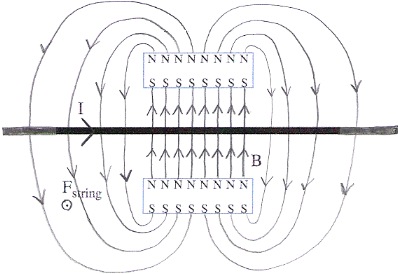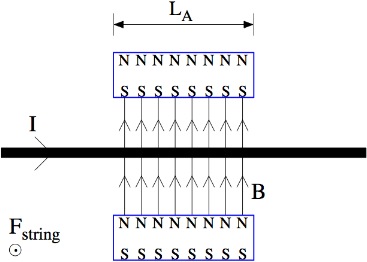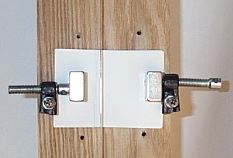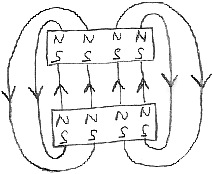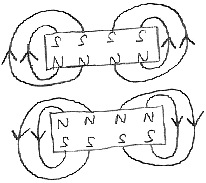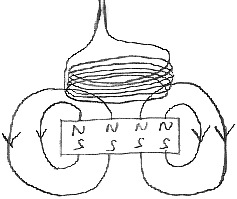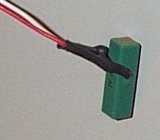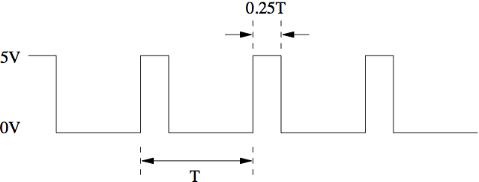Difference between revisions of "Actuators"
m (→Solenoids) |
m (→Solenoids) |
||
| Line 105: | Line 105: | ||
=== Solenoids === | === Solenoids === | ||
| − | Ajay Kapur's MahaDeviBot uses [www.mistic.ece.uvic.ca/publications/2007_icmc_mahadevibot.pdf solenoids | + | Ajay Kapur's MahaDeviBot uses [http://www.mistic.ece.uvic.ca/publications/2007_icmc_mahadevibot.pdf solenoids to actuate drums]. |
<br> | <br> | ||
Revision as of 07:16, 20 October 2008
We can affect the world directly by using actuators. Some extra parts are involved because actuators generally require that relatively large currents flow through them in order to provide relatively large forces. The signal flow diagram including a force signal generator, power amplifier, and actuator is shown below.
Contents
Acoustic System Actuators
Often we would like to induce vibrations spanning the entire range of human hearing. Here we explain how to induce these vibrations in air and in structures. Here is one particularly small but powerful audio power amplifier.
Vibrations in Air
Loudspeaker Driver
Loudspeaker drivers convert an electrical signal into pressure waves in air. These are quite common, so we refer the reader to Hyperphysics and Wikipedia. Since loudspeaker drivers are usually linear actuators, their maximum displacement is usually limited.
For instance, loudspeaker drivers can be used to actuate percussive instruments. The figure below shows a small plastic container glued to a loudspeaker cone. Shakers can be placed inside the plastic container, or the loudspeaker can be inverted and placed on top of a drumhead, allowing the plastic container to strike the drum membrane when a current is applied to the loudspeaker.
Vibrations in Structures
Lorentz Force Actuator
The Lorentz force is the force on an electrical current carrier in the presence of a magnetic field. Any element can be actuated according to the Lorentz force if an electrical current can be passed along it.
We present the example of actuating a vibrating string. An electrically conductive vibrating string is placed between two permanent magnets. Notice that the field flowing from the north pole of the upper magnet to the south pole of the lower magnet is much less focused.
For simplicity of analysis, we assume that the magnetic field B is completely uniform in between the magnets. Since the field flowing back is so much less focused, we also assume that it never flows back to complete the magnetic circuit:
Then the force on the string is F= LAI × B
A piece of wire of only about 1m in length has a relatively low resistance. In order to connect it to the output of a typical audio power amplifier, it must be placed in series with power resistors to avoid overloading the audio amplifier’s output. The next two figures show a realization in the laboratory.
The other electrodynamic actuators described here such as woofers, shakers, servomotors, solenoids, etc. operate according to this principle.
Reluctance Force Actuator
Replacing one of the permanent magnets with an electromagnet. The direction of the current through the coil determines whether the two magnets attract or repell one another:
What if you want to actuate something that isn't a magnet? Most efficient solution: glue a small neodymium magnet to the object that is to be actuated. Alternate solution: if the object is ferrous (magnetically "sticky" aka magnetizable such as iron or steel), then the object to be actuated can be magnetized by placing it in the neighborhood of a magnet. The E-Bow and the Sustainiac use this principle to actuate guitar strings.
See the Electromagnetically-Prepared Piano Project for details on how to actuate piano strings. The parts are listed here.
Piezoelectric Actuators
Haptic System Actuators
If it is sufficient to induce slower vibrations at relatively lower frequencies, for instance for interfacing with the human motor system, then we can use more conventional actuators. The Pulse Width Modulation (PWM) output of the AVR can serve as the force signal generator.
Controlling With AVR
Foremost of course is a DC motor. It also needs a motor controller, which supplies the needed voltage and current to the motor, including the direction of current. The direction of current through the motor determines the rotational direction of the motor: clockwise or counter clockwise.
Pulse Width Modulation (PWM) is a technique that we use to control the speed of the motor. A DC motor's speed is determined by now much current is flowing through it. Intuitively, if we supply a low DC current, the motor will spin slowly. It will spin more quickly with a higher current. As it turns out, it is difficult to create a circuit that supplies a varying current like this. So, we use PWM. Pulse Width Modulation used two discrete values of current (none and full) in pulses that average to the desired current value you need to make the motor act as you want. The longer the pulse, more average current flows through the motor, and the faster it goes. We speak of the length of the pulse in terms of something called the Duty Cycle. For example, in the figure below, the duty cycle is 25%.
PWM can be used to control the apparent output intensity of LED's, too!
Servo motors
Since linear motors support only limited displacements, it is often more convenient to use rotational motors. If the motor is a DC motor, then the torque (rotational force) it exerts is proportional to the electrical current flowing through it. Servo motors have rotary encoders built in so that they can also sense the rotational angle of the shaft.
Solenoids
Ajay Kapur's MahaDeviBot uses solenoids to actuate drums.
See the MAXLAB wiki page for ideas on where to get parts for actuation.

